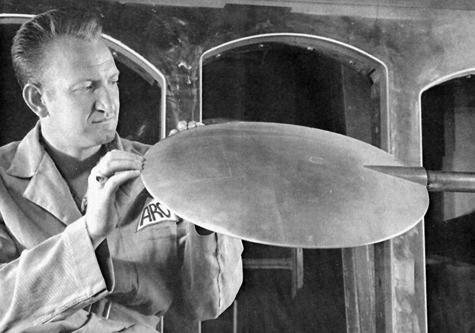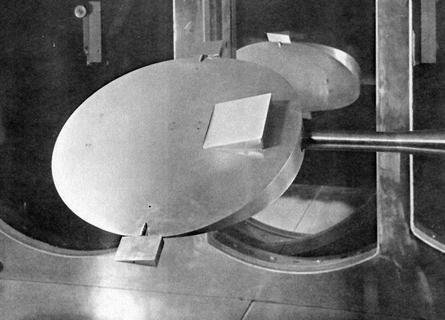Convair Pye Wacket
When the North American XB-70 Valkyrie Mach 3 bomber was developed in the late 1950s, the U.S. Air Force was faced with the problem of how to defend it against existing and future soviet air-defense weapons. It was expected that the B-70's high operating speed and altitude would not make it immune from nuclear-tipped surface-to-air and air-to-air missiles. The proposed solution was the DAMS (Defensive Anti-Missile System).
The DAMS would have to use an extremely fast and manoeuverable missile to intercept fighters and missiles approaching at relative speeds of up to Mach 7 (as could be the case for a head-on attack). One possible solution was a radical missile design developed under project Pye Wacket (see source [2] for an explanation of the peculiar name) since 1958. The Pye Wacket missile was a basically circular flying disc, and was formally called the Lenticular Defense Missile (LDM). This shape showed high supersonic stability and lift even at extreme angles of attack, and its evenly distributed mass made the needed super-agility possible. The LDM was originally designed and studied by the Air Proving Ground Center at Eglin AFB and the Arnold Engineering Development Center (AEDC). In June 1959, Convair received a contract to continue development.
 |
| Photo: AEDC, via Joel Carpenter |
| Pye Wacket (early wind tunnel model) |
During 1959 and 1960, Convair's studies and wind-tunnel tests at the AEDC evaluated various disc cross sections and control devices, the latter including several kinds of flaps, vanes, and other moving surfaces. In the end, a wegde-shaped airframe section and a reaction control system with six thrusters (4x pitch/roll, 2x yaw) was deemed the best solution. The design of the first Pye Wacket test vehicle was a disc with a diameter of 1.5 m (5 ft), a maximum thickness of about 30 cm (12 in) and a gross weight of 190 kg (425 lb). It was to be powered by three Thiokol M58A2 solid-fueled rocket motors (the same model as in early AIM-4 Falcon missiles). It was planned to launch these vehicles from a rail launcher mounted on a rocket sled in 1960. It has been reported that some flight tests were actually conducted in 1960, but this is unconfirmed.
 |
| Photo: AEDC, via Joel Carpenter |
| Pye Wacket (later wind tunnel model) |
Thanks to its symmetric shape (which was, however, compromised in Convair's wedge-shaped design), the operational LDM was to be launched from the B-70 in any direction directly towards the target. For mid-course guidance, the Pye Wacket would have used targeting information given to it before launch by the B-70's fire-control system, and terminal guidance would have been provided by an infrared seeker in the missile's "nose". The characteristics of the LDM apparently evolved somewhat over time, and a USAF report from the later phase of the program describes it as being 1.8 m (70 in) in diameter, 23 cm (9 in) deep and weighing 230 kg (510 lb). Two solid-fueled rocket motors of 45.4 kN (10200 lb) thrust propelled the missile to a speed of Mach 6.5, and maximum range was about 133 km (72 nm). However, source [1] attributes these characteristics to an earlier design stage.
It can be assumed that the Pye Wacket project was terminated in the 1960/61 time frame. At that time, actual use of defensive air-to-air missiles by the B-70 had been cancelled anyway.
Specifications
Data for Pye Wacket (proposed operational configuration):
| Diameter | 1.8 m (70 in) |
| Depth | 23 cm (9 in) |
| Weight | 230 kg (510 lb) |
| Speed | Mach 6.5 |
| Range | 133 km (72 nm) |
| Propulsion | 2x solid-fueled rocket; 45.4 kN (10200 lb) |
| Warhead | High-explosive |
Main Sources
[1] Dennis R. Jenkins, Tony R. Landis: "Valkyrie: North American's Mach 3 Superbomber", Specialty Press, 2004
[2] Joel Carpenter: "Pye Wacket - Agile as a witch's cat" Website
(originally at http://www.ufx.org/rvs/pyewacket.htm, now dead link)
[3] Giesbert Nijhuis: "Identified Flying Objects" Website
Back to Directory of U.S. Military Rockets and Missiles, Appendix 4
Last Updated: 25 January 2005